The Red Army's Mosin-Nagant 91/30 PU.
With hostilities in Europe in full swing, Zeiss stopped delivering optics for PE/PEM scopes in 1940, and production of the 91/30 PE sniper rifle stopped in the summer of 1940. The Russians, though, foresaw the loss of German suppliers for critical wartime materials and had begun a program to produce a simplified scope that culminated in the entirely Russian-produced PU scope designed in 1940. The PU scope was fitted to the semiautomatic SVT-40 rifle, and for a period longer than a year the SVT-40 was the only production sniper rifle available to the Soviet army. The loss of many sniper rifles in combat during late 1941 — and the forced relocation of many critical manufacturing facilities due to the German advance — resulted in serious shortages of sniper rifles through most of 1942. In early August 1942, the SVT-40 was deemed to have unacceptable performance as a sniper rifle and production was stopped in October 1942. From mid-’41 to mid-’42, the Soviets were developing a simpler and easier-to-produce scope mount for the 91/30 rifle to accept the PU scope. The Model 1942 Kochetov was the resulting mount. The 91/30 PU rifle was accepted in late August 1942 and production was scheduled to begin in September, but Tula Arsenal did not begin production until December. Izhevsk Arsenal produced only a few rifles by the end of 1942. Tula produced rifles until May 1944, and Izhevsk stopped production in December 1944. Izhevsk produced approximately another 2,500 rifles in 1947. Exact production numbers are unclear, but from historical evidence, it is believed that around 100,000 rifles were produced.
The PU scope is short with simple optics and mechanics, and a 28.7mm constant diameter. It used a sharply pointed and slender post reticle to provide precise aiming, even with the lower power of 3.5X. The scope has friction elevation and windage turrets with adjustment scales that can be easily loosened and slipped to provide precise turret zeroing. The scope mount is a rugged design that attaches to the side of the receiver. The mount has a base that screws to the side of the receiver with a ball-hemisphere detent in the front of it, offsetting screws for gross elevation adjustment at the rear of the base, and a large screw that clamps the rings to the base. The scope rings have metal tabs that are captured under the large screw in the base. It can be filed or shimmed to achieve a windage turret zero in the middle of the scope’s optical field. The scope rings have a ball on the forward end that inserts into the detent in the base. This setup allows gross adjustments of the scope for elevation and windage in the base to get the scope turrets to zero and center within the optical center of the scope. It’s a simple but robust scope mounting that allows easy adjustment for centering of the scope. Getting a zero with the 91/30 that maximizes the elevation and windage adjustment of the scope is easy. Zeroing the PU scope turrets is also simple. Each turret has two small screws on the top that are loosened as you hold the turret, and the elevation or windage scale is slipped to zero. The screws are then carefully tightened, making sure the turret is not turned. Then you’re done. The elevation scale has a tab on it that provides a zero-stop.
The elevation turret is calibrated to an optimistic 1,200 meters for the 148-grain light-ball 7.62x54R round. Mosin-Nagant 91/30 rifles selected for conversion to a sniper rifle were chosen based on their accuracy when tested at the factory. Triggers were reworked to lighten the pull weight and improve the trigger’s crispness. A longer bent bolt handle was also added to the bolt. Despite the crude appearance, poor fit and finish, and horrible trigger, the 91/30 PU was a rugged and dependable rifle. After getting used to the trigger, it also proved to be accurate.
In his personal memoir, “Notes of a Russian Sniper” (1956), Zaitsev described many of his engagements in Stalingrad, most inside 300 meters with several engagements around 500 meters. Josef “Sepp” Allerberger, a German sniper who started his sniper career with a captured Russian 91/30 sniper rifle, recalled an engagement with the rifle in his memoir “Sniper on the Eastern Front” (2005) where he shot a Russian soldier sunbathing on a river beach at what he estimated to be 600 meters. He also wrote that most of his shots were inside 400 meters. These ranges are well within the capability of the 91/30 sniper rifle, as observed during Guns & Ammo’s test results. (Claims for the number of kills and feats of Russian snipers during the war were heavily overlayed with Soviet propaganda and exaggeration.)
My test rifle is an original 1944 Izhevsk 91/30 PU that went through a refurbishment after the war with a 1953-produced scope. As good as the bore is, I’m not sure it was ever issued. I did nothing to the rifle other that clean it up. The trigger was mushy with a very light second stage that broke consistently at 3 pounds, 7 ounces. It took some getting used to. The gun and scope combination came in at a reasonable weight of 10.2 pounds.
At The Range
Testing was done on a known-distance (KD) range with targets at 100, 200, 300, 400 and 500 yards. The B27 human silhouette target was used to match the sight picture that would have existed in view of a sniper. With all loads, we only fired three-shot groups at each distance due to the limited supply of ammunition. We zeroed the 91/30 PU with a handload consisting of a Sierra 174-grain .312-inch MatchKing bullet and 45.7 grains of IMR 4064 with several five-shot groups. We then fired three-shot groups at the increasingly distant targets by dialing the elevation turret for range. The calibration of the elevation turret settings was right on with the issued
Editor-in-Chief Eric Poole was the trigger man, and I spotted and gave him wind calls. We did not try to dial for wind because that’s a good way to get into trouble with these old scopes. There is a small amount of crosstalk between the windage turret and the elevation turret in the PU scope, and by “crosstalk” I mean that making a windage adjustment will also move the scope’s elevation. Other than the minor crosstalk in the PU scope, we found the adjustments were precise and repeatable. As with all old scopes, we needed to adjust in the same direction or go beyond the desired setting and come back to it in the same direction every time. This is due to backlash.
Our standard practice was to shoot in the same wind condition as the other sniper rifles being compared. Wind calls were based on wind flags and observing vegetation. It was too windy to read mirage, unfortunately. We succeeded most of the time, but several of the groups showed an obvious miss of a wind condition. With the low-power scope, wind corrections were generally “hold right side,” “hold right-edge of silhouette,” and “hold right-edge of cardboard.” Greater resolution wasn’t possible beyond 400 yards. Every time we had a group size that didn’t fit with results at ranges on either side of the target, we had a bullet out either left or right. Elevation was always much better than the windage of the group, particularly at 500 yards.
Parting Shot
We felt the Mosin-Nagant 91/30 PU was an accurate sniper rifle with Soviet-issue light ball ammunition. Accuracy was on the order of 1½ minute of angle (MOA). We determined that this was a rather stunning performance from a World War II-period rifle, scope and ammunition. Head shots were predictably realistic to 300 yards with the 91/30 PU, and body shots were effective to at least 600 yards. In better wind conditions, a body shot could be likely to 700 yards. With the sharp and slender post reticle, target resolution of a human-size target is good at 500 yards. Overall, the shooting experience with the 91/30 PU with period ammunition was surprising and satisfying. This was a lethal and effective sniper rifle.
Part 1 - The German Mauser Model 98k
Part 2 - Britain's Enfield No. 4 Mark 1 (T) and No. 32 Scope
Related Categories
Article courtesy of Guns & Ammo.
 |
| (Photo by Mark Fingar) |
The Soviet’s Mosin-Nagant 91/30 PE/PEM/PU sniper rifles were a paradox. To some, the 91/30 rifles appeared akin to a 2-by-4. Many had poor fit and finish, a rough action and a horrible trigger. The sniper rifle variants were equipped with a crude scope: Either a 4x20mm PE model, a modernized PEM scope or the PU 3.5x20mm scope. The 4x20mm PE entered service in November 1931 and was produced by the Leningrad factory No. 357 until 1940. The modernized PEM scope was made from 1937 to 1940 and 1942 to 1943, and the PU 3.5x20mm scope was made from 1941 and into the post-war period.
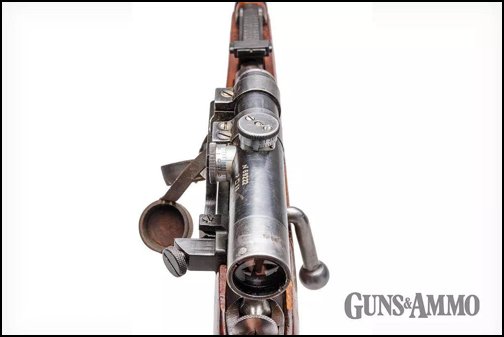 |
| The Soviet-made 3.5X PU scope measured 6.65 inches in length and weighed 9.52 ounces. It was developed for sniper use with the semiautomatic SVT-40. (Photo by Mark Fingar) |
Most first impressions of the Mosin-Nagant 91/30 sniper are true until you get used to the trigger and seriously shoot it. With some time behind a 91/30 PE or PU, your preconceived opinions might change. The 91/30 sniper rifles have earned a reputation for accuracy. My original 91/30 PU did not disappoint during Guns & Ammo’s evaluation. The scope’s simplicity is one of its best features and works well with the rifle.
To that end, the perception I had of Soviet Bloc ammunition as “cheap” and “poor performing” was proved untrue. The three types of ammunition used to evaluate our sample 91/30 PU performed very well.
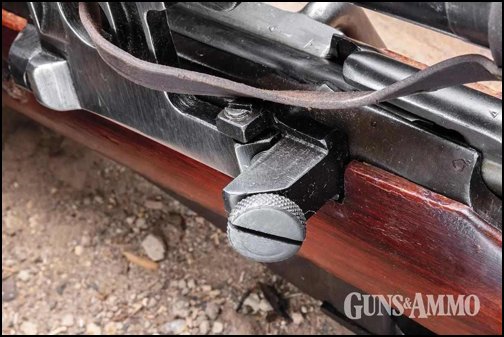 |
| The large, knurled, slotted scope-base screw at the back secures the PU scope mount to the receiver scope bracket. Two screws, one above and below, eliminate the play in the mount. (Photo by Mark Fingar) |
Soviet Sniper Rifles & Optics
The Soviets had the most successful employment of snipers during World War II because of their sniper training program, which was established during the early 1930s, and the standardization of a sniper rifle at the same time. The Mosin-Nagant 91/30 sniper rifle was accepted in 1932 and originally fitted with the 4X PE scope. The PE scope was a copy of a German Zeiss design, with optics supplied by Zeiss from Germany. It went through several manufacturing simplification changes during the eight years it was produced. Unlike the depiction in the movie “Enemy at the Gates” (2001), sniper Vasily Zaitsev used a 91/30 PE rifle — not a 91/30 PU — during his service in Stalingrad.
 |
| Two screws on each windage and elevation turret can be loosened. Once the rifle has been zeroed to a load, loosen the screws to lift each turret and rotate to “0” to zero the markings. (Photo by Mark Fingar) |
With hostilities in Europe in full swing, Zeiss stopped delivering optics for PE/PEM scopes in 1940, and production of the 91/30 PE sniper rifle stopped in the summer of 1940. The Russians, though, foresaw the loss of German suppliers for critical wartime materials and had begun a program to produce a simplified scope that culminated in the entirely Russian-produced PU scope designed in 1940. The PU scope was fitted to the semiautomatic SVT-40 rifle, and for a period longer than a year the SVT-40 was the only production sniper rifle available to the Soviet army. The loss of many sniper rifles in combat during late 1941 — and the forced relocation of many critical manufacturing facilities due to the German advance — resulted in serious shortages of sniper rifles through most of 1942. In early August 1942, the SVT-40 was deemed to have unacceptable performance as a sniper rifle and production was stopped in October 1942. From mid-’41 to mid-’42, the Soviets were developing a simpler and easier-to-produce scope mount for the 91/30 rifle to accept the PU scope. The Model 1942 Kochetov was the resulting mount. The 91/30 PU rifle was accepted in late August 1942 and production was scheduled to begin in September, but Tula Arsenal did not begin production until December. Izhevsk Arsenal produced only a few rifles by the end of 1942. Tula produced rifles until May 1944, and Izhevsk stopped production in December 1944. Izhevsk produced approximately another 2,500 rifles in 1947. Exact production numbers are unclear, but from historical evidence, it is believed that around 100,000 rifles were produced.
 |
| Once windage was zeroed at 100 yards, only the elevation turret was adjusted for subsequent groups. Elevation adjustments were precise and repeatable to 500 yards. (Photo by Mark Fingar) |
The PU scope is short with simple optics and mechanics, and a 28.7mm constant diameter. It used a sharply pointed and slender post reticle to provide precise aiming, even with the lower power of 3.5X. The scope has friction elevation and windage turrets with adjustment scales that can be easily loosened and slipped to provide precise turret zeroing. The scope mount is a rugged design that attaches to the side of the receiver. The mount has a base that screws to the side of the receiver with a ball-hemisphere detent in the front of it, offsetting screws for gross elevation adjustment at the rear of the base, and a large screw that clamps the rings to the base. The scope rings have metal tabs that are captured under the large screw in the base. It can be filed or shimmed to achieve a windage turret zero in the middle of the scope’s optical field. The scope rings have a ball on the forward end that inserts into the detent in the base. This setup allows gross adjustments of the scope for elevation and windage in the base to get the scope turrets to zero and center within the optical center of the scope. It’s a simple but robust scope mounting that allows easy adjustment for centering of the scope. Getting a zero with the 91/30 that maximizes the elevation and windage adjustment of the scope is easy. Zeroing the PU scope turrets is also simple. Each turret has two small screws on the top that are loosened as you hold the turret, and the elevation or windage scale is slipped to zero. The screws are then carefully tightened, making sure the turret is not turned. Then you’re done. The elevation scale has a tab on it that provides a zero-stop.
 |
| Mosin-Nagant 91/30s selected to be sniper rifles were retrofitted with turned-down bolt handles. The two-lug bolt was also serialized to match the number of the receiver. (Photo by Mark Fingar) |
The elevation turret is calibrated to an optimistic 1,200 meters for the 148-grain light-ball 7.62x54R round. Mosin-Nagant 91/30 rifles selected for conversion to a sniper rifle were chosen based on their accuracy when tested at the factory. Triggers were reworked to lighten the pull weight and improve the trigger’s crispness. A longer bent bolt handle was also added to the bolt. Despite the crude appearance, poor fit and finish, and horrible trigger, the 91/30 PU was a rugged and dependable rifle. After getting used to the trigger, it also proved to be accurate.
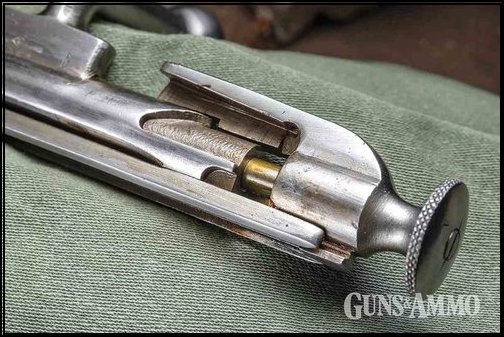 |
| The cocking knob is used to re-cock the rifle during a misfire without working the bolt; pull it back until the sear engages it. Turn it counterclockwise to engage the safety. (Photo by Mark Fingar) |
In his personal memoir, “Notes of a Russian Sniper” (1956), Zaitsev described many of his engagements in Stalingrad, most inside 300 meters with several engagements around 500 meters. Josef “Sepp” Allerberger, a German sniper who started his sniper career with a captured Russian 91/30 sniper rifle, recalled an engagement with the rifle in his memoir “Sniper on the Eastern Front” (2005) where he shot a Russian soldier sunbathing on a river beach at what he estimated to be 600 meters. He also wrote that most of his shots were inside 400 meters. These ranges are well within the capability of the 91/30 sniper rifle, as observed during Guns & Ammo’s test results. (Claims for the number of kills and feats of Russian snipers during the war were heavily overlayed with Soviet propaganda and exaggeration.)
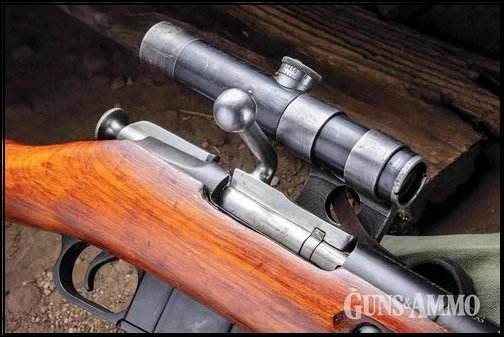 |
| Having two lugs, the bolt of the 91/30 features a 90-degree throw that requires little effort to lift. When the turned-down bolt handle was lifted, it did not interfere with the mounted scope. (Photo by Mark Fingar) |
My test rifle is an original 1944 Izhevsk 91/30 PU that went through a refurbishment after the war with a 1953-produced scope. As good as the bore is, I’m not sure it was ever issued. I did nothing to the rifle other that clean it up. The trigger was mushy with a very light second stage that broke consistently at 3 pounds, 7 ounces. It took some getting used to. The gun and scope combination came in at a reasonable weight of 10.2 pounds.
 |
| (Photo by Mark Fingar) |
7.62x54R Ammunition
The principal load of the Soviet army during World War II was the 148-grain spitzer, flat base, lead core, light ball load. A 182-grain heavy ball load was also issued and primarily used in machine guns. The elevation turret on the PU scope is calibrated for the light ball load. Russian snipers made regular use of a high-explosive incendiary (HEI) round that had a firing pin, incendiary mix and a small explosive charge. It weighed 160 grains. Allerberger noted that captured HEI rounds were coveted and used for high-value targets. The Russians also had armor piercing (AP), armor piercing incendiary (API), tracer, and armor piercing incendiary tracer (API-T) loads, but none were as accurate as the light ball load. I have not encountered any reports of Russian special sniper ammunition in World War II. For this evaluation, I acquired a small quantity of Russian 1945 light ball ammunition, 1971 Bulgarian steel core light ball, and 2020 light ball from Red Army Standard.
 |
| The serial number appears on many parts of the 91/30, including the magazine floorplate, bolt, buttplate and receiver. According to its markings, the author’s test rifle was manufactured in 1944. (Photo by Mark Fingar) |
At The Range
Testing was done on a known-distance (KD) range with targets at 100, 200, 300, 400 and 500 yards. The B27 human silhouette target was used to match the sight picture that would have existed in view of a sniper. With all loads, we only fired three-shot groups at each distance due to the limited supply of ammunition. We zeroed the 91/30 PU with a handload consisting of a Sierra 174-grain .312-inch MatchKing bullet and 45.7 grains of IMR 4064 with several five-shot groups. We then fired three-shot groups at the increasingly distant targets by dialing the elevation turret for range. The calibration of the elevation turret settings was right on with the issued
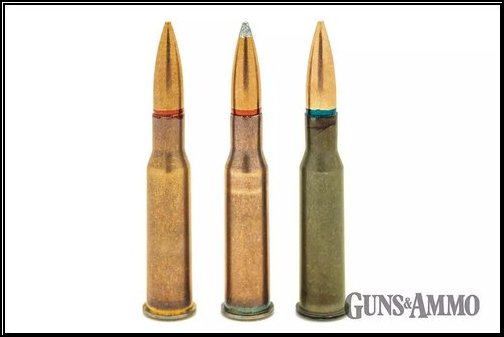 |
| Test ammunition for the Mosin-Nagant 91/30 PU included (above, left to right): 1945 148-gr. light ball; 1971 Bulgarian 147-gr. steel core light ball; and 2020 Red Army Standard 148-gr. light ball. (Photo by Mark Fingar) |
Editor-in-Chief Eric Poole was the trigger man, and I spotted and gave him wind calls. We did not try to dial for wind because that’s a good way to get into trouble with these old scopes. There is a small amount of crosstalk between the windage turret and the elevation turret in the PU scope, and by “crosstalk” I mean that making a windage adjustment will also move the scope’s elevation. Other than the minor crosstalk in the PU scope, we found the adjustments were precise and repeatable. As with all old scopes, we needed to adjust in the same direction or go beyond the desired setting and come back to it in the same direction every time. This is due to backlash.
 |
| The 91/30 triggerguard features a relief for the middle finger at the rear. The latch to release the floorplate is at the front. (Photo by Mark Fingar) |
Our standard practice was to shoot in the same wind condition as the other sniper rifles being compared. Wind calls were based on wind flags and observing vegetation. It was too windy to read mirage, unfortunately. We succeeded most of the time, but several of the groups showed an obvious miss of a wind condition. With the low-power scope, wind corrections were generally “hold right side,” “hold right-edge of silhouette,” and “hold right-edge of cardboard.” Greater resolution wasn’t possible beyond 400 yards. Every time we had a group size that didn’t fit with results at ranges on either side of the target, we had a bullet out either left or right. Elevation was always much better than the windage of the group, particularly at 500 yards.
 |
| The horizontal bar is a spring pressed into the lower forend of the stock, which applies pressure to the barrel band. (Photo by Mark Fingar) |
Parting Shot
We felt the Mosin-Nagant 91/30 PU was an accurate sniper rifle with Soviet-issue light ball ammunition. Accuracy was on the order of 1½ minute of angle (MOA). We determined that this was a rather stunning performance from a World War II-period rifle, scope and ammunition. Head shots were predictably realistic to 300 yards with the 91/30 PU, and body shots were effective to at least 600 yards. In better wind conditions, a body shot could be likely to 700 yards. With the sharp and slender post reticle, target resolution of a human-size target is good at 500 yards. Overall, the shooting experience with the 91/30 PU with period ammunition was surprising and satisfying. This was a lethal and effective sniper rifle.
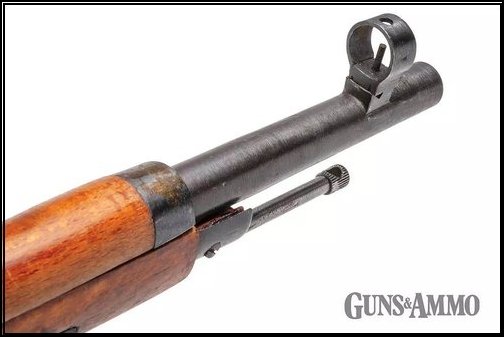 |
| The Type 2 hooded post sight was used on the 91/30 and is unmarked except for an alignment index mark on the front. (Photo by Mark Fingar) |
Part 1 - The German Mauser Model 98k
Part 2 - Britain's Enfield No. 4 Mark 1 (T) and No. 32 Scope
Related Categories
Mosin-Nagant Rifles for sale
Sniper Rifles for sale
Check out the great selection of Rifles for sale online at GunsInternational.com.
Sniper Rifles for sale
Check out the great selection of Rifles for sale online at GunsInternational.com.
Article courtesy of Guns & Ammo.












